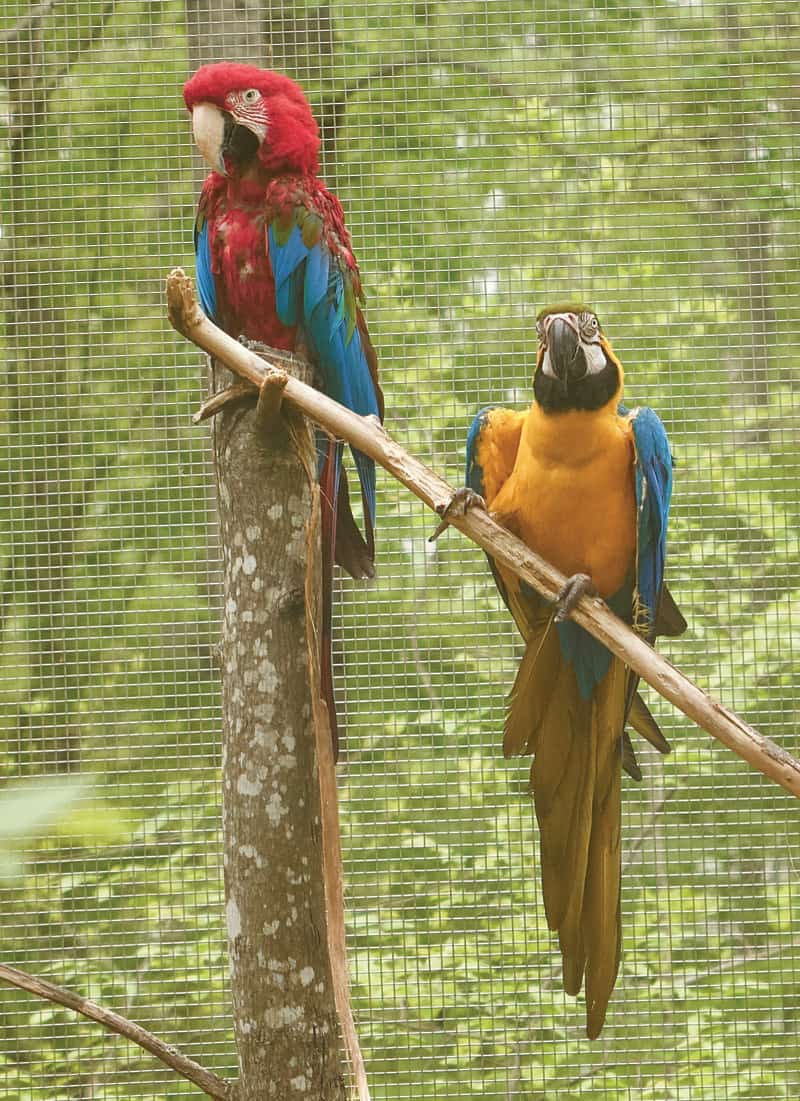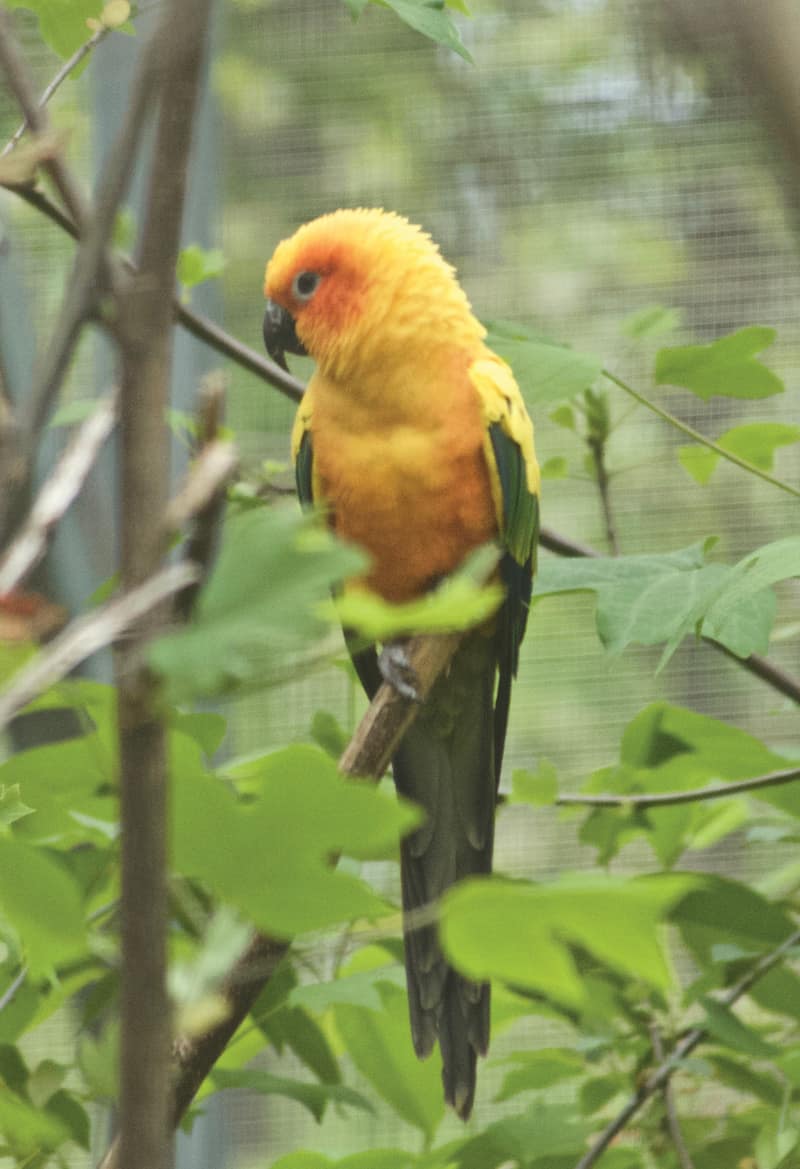Central Virginia Parrot Sanctuary: Where Caged Birds Fly High
Louisa sanctuary is one of six in U.S.

Tucked into the woods a few miles north of the town of Louisa, you’ll find a very unlikely avian menagerie. An unmarked gravel road leads to several large and sumptuous aviaries that are homes to exotic “cage birds.” The birds are residents of the Central Virginia Parrot Sanctuary (aka Project Perry), one of six sanctuaries in North America that are accredited by the Global Federation of Animal Sanctuaries, an achievement that assures a high standard of health and well-being.
Sanctuary residents reach their new home for a variety of reasons. Some caretakers are unable to care for their birds because of advanced age, poor health or the cost of health care for their birds. Some birds live there as beneficiaries of their owners’ estate plans. Some parrot species may have long lifetimes, often many decades, and owners simply tire of the year-after-year upkeep and want to be relieved of responsibility.
Unfortunately, a number of sanctuary residents are rescued from neglectful and abusive living conditions. For a variety of reasons, owners do not maintain a safe and healthy milieu, so removal is the optimal outcome.
You’ll find a wide range of exotic birds at Project Perry: cockatiels, finches, brilliant sun conures, splashy scarlet macaws and many African gray parrots.
SMART AS A 5-YEAR-OLD, FEISTY AS A 2-YEAR-OLD
African grays are often considered the “Einsteins” of the parrot family because of their unusual ability to mimic human speech and communicate with their caretakers. Some owners say that the African grays have the intelligence level of a 5-year-old and the temperament of a 2-year-old. Not as colorful as other cage birds, grays have taupe to slate gray plumage, but the tips of their tails are reddish.
My introduction to African grays was a real eye-opener. A fellow birder had adopted one that had been kept by a distant relative for several years, and although he was not particularly keen about cage birds, it wasn’t long until there was a strong bond between the gray and the new caretaker.
On my first visit to his home, I found every nook and cranny of the downstairs filled with greenery: twisting vines, spidery ferns and all sorts of exotic plants. In one corner there was a large cage with a thick tree branch attached, where a perched African gray watched me intently. Recorded tropical birdcalls and eerie jungle howls wafted nonstop throughout the house, and it was clear that bird and human had successfully bonded.
I visited Project Perry in June during an open house, and as I entered the African gray aviary accompanied by genial staff and sanctuary director Matt Smith, the 40 or so birds greeted us with loud calls and several “hellos.” Smith, who had worked at a similar sanctuary in New Hampshire, moved to Louisa to be near family and has developed a 15-acre paradise for his charges.
Some of the gregarious birds moved closer as we entered, and as we walked the length of the aviary at least three flew to my shoulders or hopped from perches to my baseball-cap-covered head. The birds contentedly lolled about both the open area and enclosed shelter, and from the smile on Smith’s face it was clear he enjoyed the company of the African grays.
PEACOCKS OF THE PARROT FAMILY

Not far away, another expansive aviary was home to several scarlet macaws, the peacocks of the parrot family: large eye-catching birds with vibrant multicolored plumage. Seventeen species of macaws are found in Central and South America and are considered rainforest birds. The birds are listed as endangered or threatened by the International Union of Conservation of Nature because of habitat loss and captures for the pet trade.
My first sighting of scarlet macaws was in Costa Rica on my premier birding trip outside of the U.S. These bright red, yellow and blue long-tailed birds are the largest of the parrot family. Often crisscrossing mountaintops in small flocks while searching for food, the parrots are attention-getters as they noisily call to each other.
Years later in Ecuador along the Napo River in the Amazon Basin, I saw a flock of smaller parrots perched over the water’s edge waiting for the bravest to signal that the coast was clear to approach the steep clay riverbank below. Ingesting clay gives parrots a nutritional boost for their sodium-poor diet. First one, then three warily fluttered to the bank, and soon the rest of the flock gingerly drifted down to join them to dig up and eat the clay.
Unexpectedly, a dozen scarlet macaws appeared from the trees to join the flock at the clay lick, displaying a kaleidoscope of brilliant colors. The group of parrots dug into the clay riverbank in complete silence for nearly 15 minutes before gradually returning to the rainforest.
Visitors can view the Project Perry macaws from outside of the screened aviary, and the birds appear peaceful and sanguine as their colorful plumage contrasts with the verdant green interior. Several pairs huddled together while others flew back and forth the length of the their spacious lodging.
AND THEN SOME
A smaller aviary houses a flock of sun conures, sometimes called “little macaws,” a playful and noisy parrot about the size of a small pigeon. You’ll recognize them by their lemon yellow and bright orange upper body plumage. Among the Project Perry residents, conures and macaws are rivals for sheer brilliance.
Seeing the sumptuous living arrangements provided in the Project Perry aviaries, it’s easy to understand why individual parrot owners would want to set up an estate plan to assure future care for their feathered family member. And we can all appreciate that birds rescued from neglectful or abusive surroundings now have optimal dwellings for their lifetime care.
Here in the woods of Louisa County, Project Perry is truly a sanctuary for some unusual and delightful parrots. Thanks to Cas Overton of the Richmond Quaker Birders for introducing me to this avian gem. You can find details about Central Virginia Parrot Sanctuary and scheduled tours at ProjectPerry.com.
For 20 years, Jerry Uhlman has been writing about birding and travel. Besides his column in the Richmond Times-Dispatch, his stories have appeared in a variety of national publications, including Bird Watcher’s Digest, Living Bird and National Geographic’s Bird Watcher. His book, A Birder’s Guide to Metropolitan Richmond, is available at Lewis Ginter Botanical Garden, Wild Birds Unlimited, Yardbirds, Wild Bird Center of Midlothian and Bird Watchers. Flyways@verizon.net


